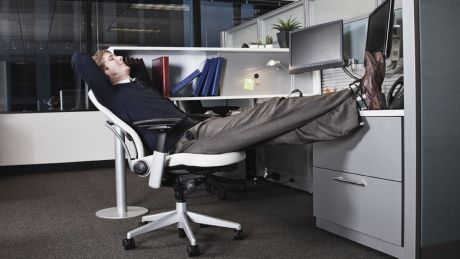How To Power Nap At Work – And Why
Kill the afternoon slump with a quick snooze. Sorry, make that “controlled recovery period”

Despite counting the likes of Winston Churchill and Bill Clinton among its advocates, napping has a bad rep, with most people preferring to push through drowsy daytime spells rather than catching 40 winks, but taking an afternoon power nap can improve heart health, according to the Journal Of Psychophysiology. And the key to a mid-afternoon mini-snooze is a well-timed cup of coffee, says Yann Le Meur, a sports scientist at the French Institute of Sport. Use his tips to make 40 winks work for you.
Set the scene
“Turn off your mobile phone and any other potential distractions,” says Le Meur. “If background noise is unavoidable, put on headphones with relaxing music.” Wearing an eye mask to simulate darkness is his final prep tip.
Have a coffee
The idea is that the caffeine kicks in just as you’re aiming to wake up again – about 20-odd minutes after you drift into slumber. “A caffeine nap will not only improve your performance but it’ll also lessen how sleepy you feel when you wake,” says Le Meur.
Set an alarm
Factor in the five or so minutes that it’s likely to take you to fall asleep, then add about 20 minutes to that time. “If you have a habit of pressing the snooze button and going right back to sleep, put your alarm on the other side of the room,” says Le Meur.
Get going
The power nap’s done – time to harness that power. Le Meur suggests a few sets of star jumps and press-ups to get your blood flowing. Bright light and splashing water on your face will also help to get you alert and back in the game.
RECOMMENDED: Try This Instead Of Coffee To Beat The Afternoon Slump
Why You Should Power Nap At Work
To learn about napping’s benefits, Coach spoke to Nick Littlehales, elite sport sleep coach for the likes of Manchester United and Team Sky, and author of new book Sleep. His first bit of advice was to ditch the word “nap”…
Sign up for workout ideas, training advice, reviews of the latest gear and more.
“Nap is a bad word. Napping is pipe and slippers, it’s for old people in front of their televisions,” Littlehales tells Coach. “We talk about controlled recovery periods [CRP] in sport.” Taking naps, or indeed CRP, is especially vital given the unusual and physically demanding schedules of sportspeople, but Littlehales says everyone can benefit from adopting the polyphasic sleep approach – where you sleep multiple times a day, rather than just at night – he recommends to clients.
“We used to use three natural sleep periods every day,” explains Littlehales. “We would sleep a shorter period at night, but also either at midday or in the early evening. It was only when the light bulb was invented that most of the world started sleeping just at night.”
Most people don’t have the luxury of a flexible schedule that allows nap breaks in the afternoon. However, taking a 30-minute break, even if you don’t actually sleep, at lunchtime is only likely to make you more productive.
“Just after lunch is a corporate graveyard slot in business,” adds Littlehales. “People fall asleep in meetings. If you go just semi-conscious for a while, you can raise alertness around 54%.” That figure comes from a 1995 NASA study on long-haul pilots that found that “a 26-minute nap improved performance 34% and alertness 54%.”
The good news is you don’t have to make it a big deal. No special sleep pods or soothing whale noises required. It just takes 30-minutes of zoning out, whether it’s at your desk with headphones on, or sitting on a park bench. “The most important thing is not to put yourself under pressure, just start the process. This is not something new. It’s not something a guru has created. It’s absolutely natural and designed to help us.”
Between 1-3pm in the afternoon, and in the late afternoon/early evening (5-7pm), are the ideal times to schedule 30 minutes of shut-eye. You should be able to get 20-25 minutes of mental recovery, even if you don’t actually sleep. To avoid any post-nap grogginess, drink a shot of espresso just before the break. The caffeine should kick in just as your nap finishes.
Nick’s book Sleep, published by Penguin Life, £9.99, is available from October 27. Buy on amazon.co.uk.

Nick Harris-Fry is a journalist who has been covering health and fitness since 2015. Nick is an avid runner, covering 70-110km a week, which gives him ample opportunity to test a wide range of running shoes and running gear. He is also the chief tester for fitness trackers and running watches, treadmills and exercise bikes, and workout headphones.
